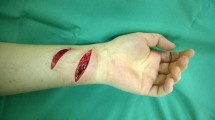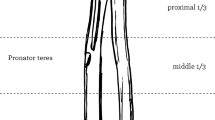Abstract
Background
Isolated palmar dislocation of distal radioulnar joint is a rare injury. It can easily lead to misdiagnosis. Previous literature reports were all rotation violence. We reported a patient with direct impact violence.
Case presentation
We report a 31-year-old male laborer presented to our hospital with an acute trauma. Severe tenderness and limited mobility were seen in his right wrist. He received an x-ray film examination and diagnosed as the isolated palmar dislocation of distal radioulnar joint. The treatment was closed reduction and splint fixation. After half a year, the patient gained a functional recovery of his previously afflicted wrist.
Conclusions
To the best of our knowledge, this is the first case of isolated palmar dislocation of distal radioulnar joint caused by a direct impact violence. Patients and physicians should be aware of the properties of this mechanism of injury so that early diagnosis and treatment can be achieved.
Similar content being viewed by others
Background
Isolated palmar dislocation of distal radioulnar joint (DRUJ) is not a common injury without concomitant fracture of the distal radius or ulna [1]. Emergency physician and orthopedic surgeon may easily miss this injury, so it will leave serious functional disability [2]. This kind of simultaneous opposition impact violence has existed only in the theory, and no actual case report have been reported. We first reported this injury mechanism, treatment and outcome.
Case presentation
This is a case of a 31-year-old male laborer presented to our hospital with a direct impact trauma. He and his colleagues were installing outdoor units of air-condition. He lifts it with his right hand on the left side. Due to the unstable body, the machine was directly pressed against the radial palmar surface of his wrist, and the ulnar dorsal of his wrist hit the edge of the window sill. He felt immediate acute severe pain. The patient had no previous medical or surgical history related to the injury, and had no previous injuries to the wrist, forearm or hand. Physical examination revealed local bruising on the radial palmar side of the wrist, and abnormal bony prominences on the ulnar palmar side. The ulnar styloid was not palpable on the ulnar dorsal side of the wrist (Fig. 1). Movement of wrist was limited, movement of fingers was normal, there was no paresthesia in the fingers, and neurological function was normal. Plain X-ray films documented isolated palmar dislocation of DRUJ with soft tissue swelling. Anteroposterior X-ray films showed overlap of the distal radius and ulna. Lateral X-ray films showed palmar volar projection of the ulna relative to the radius (Fig. 2). In such a severe dislocation, we recommend magnetic resonance imaging to assess the injury of ligament, joint capsule and triangular fibrocartilage complex (TFCC). The patient refused to undergo examination and open surgery because of economic reasons. We underwent closed reduction under brachial plexus block. We used the thumb to directly press the palmar ulnar side of wrist, without rotating the wrist, and successfully reduction after hearing a sound of click. The patient’s right wrist did not dislocate again when it rotated 45 degrees of pronation and supination. Post-reduction films showed a complete reduction of dislocation (Fig. 3). A above elbow splint was used for one and half a month. The patient refused to take pain medicine and relief swelling medicine. The patient then performed normal daily work after 3 months. In a telephone follow-up 6 months later, he expressed satisfaction with his wrist function. He returned to the previous heavy physical activity. These study protocols were approved by the Medical Ethics Committee of the First Affiliated Hospital, College of Medicine, Zhejiang University.
Discussion and conclusions
In the literature, the injury mechanism of Isolated palmar dislocation of DRUJ is mainly forced hyper supination of the forearm [3,4,5,6], fall from height [7,8,9,10] and intense impact sports activities [7, 11, 12], such as football (Table 1). As mentioned above, wrist rotation and great violence are the main factors, but our case is direct impact violence, impact on opposition (Fig. 4). The weight of machine and the impact of window sill edge were both direct violence. This situation is described for the first time. We think that although it was very rare, clinical radiologists, orthopedists, and hand surgeons must understand this mechanism to prevent missed diagnosis. It is easy to miss diagnosis this trauma on the initial X-rays, especially if the lateral view was not well positioned. So, the standard lateral view or both wrists as a contrast of X-Ray film were significant for diagnosis. Ct scan is more intuitive, and MRI can evaluate the conditions of ligament, TFCC and the interosseous membrane, which maintain the stability of the DRUJ [13].
For fresh injury, patients combined with tendons or nerves injury were easy for an emergency doctor or orthopedic surgeon to notice [4]. For old injury, patients often have limited functional limitations and joint stiffness, so ct scan and MRI were available to help diagnosis [8, 9, 14] (Table 1). Due to economic reasons and wrist swelling at emergency injury, we cannot evaluate these structures such as ligaments. The volar radioulnar ligament may be ruptured, according to the weakness of the palmar soft tissue and pressure of the ulna during reduction.
The treatment generally depends on the injury mechanism, especially the closed reduction. Closed reduction, Kirschner wire fixation and cast immobilization were used when fresh injured or emergency-department visits [5, 7, 10,11,12, 15] (Table 1). Open reduction and reconstruction of ligament or TFCC were used when old injury or misdiagnosis [4, 8, 9, 14]. Although the overall number of cases is small, whether it is fresh injury or old injury, the final reported treatment results are satisfactory. For patients who have recurrent dislocation after reduction, it is very important to reconstruct the stability of DRUJ. Modified Sauve-Kapandji procedure is an option [16]. In our case, we press the prominent palmar side of ulnar head directly to successfully reduction, instead of pronating the hand like most of the time. Due to prompt diagnosis and treatment, although our patient received no ligament repair, he also achieved good wrist motion and function after splint fixation.
The direct, opposition impact violence is a rare injury mechanism that causes isolated palmar dislocation of DRJU. Clinicians must have enough knowledge and understanding of it. The treatment aim to the injury mechanism is more effective.
Availability of data and materials
The dataset supporting the conclusions of this article is included within the article.
Abbreviations
- DRUJ:
-
Distal radioulnar joint
- MRI:
-
Magnetic resonance imaging
- TFCC:
-
Triangular fibrocartilage complex
References
Weseley MS, Barenfeld PA, Bruno J. Volar dislocation distal radioulnar joint. J Trauma. 1972;12:1083–8.
Zannou RS, Rezzouk J, Ruijs ACJ. Non-reducible palmar dislocation of the distal radioulnar joint. Case Reports Plast Surg Hand Surg. 2015;2:43–5.
Axer A, Spann-Etzioni J. Dislocation of ulna at the radio-ulnar joint without fracture of radius; report on two cases. Acta Med Orient. 1949;8:54–7.
Kameyama M, Shiraishi T. Traumatic rupture of the extensor digitorum communis and extensor digiti minimi at the musculotendinous junction associated with volar dislocation of the distal radioulnar joint--a case report. Hand Surg. 2000;5:165.
Bouri F, Fuad M, Abdolenour AE. Locked volar distal radioulnar joint dislocation. Int J Surg Case Rep. 2016;22:12–4.
Schiller MG, Af EF and Kirsch PT. Volar dislocation of the distal radio-ulnar joint. A case report. J Bone Joint Surg-Am. 1991;73:617–19.
Rijal L, Sagar G, Ansari T, Joshi A, Joshi KN. Isolated volar dislocation of distal radioulnar joint: rarely occurring, commonly missed. Eur Orthop Traumatol. 2012;3:151–4.
Kohyama S, Hara Y, Fukai R, Yamazaki M. Subacute volar dislocation of the distal radioulnar joint without fracture: a case report and literature review. Trauma. 2014;17:229–34.
Kashyap S, Fein L. Surgical correction of recurrent volar dislocation of the distal radioulnar joint. a case report. Clin Orthop Relat Res. 1991;(266):85-89.
Mittal R, Kulkarni R, Subsposh SY, Giannoudis PV. Isolated volar dislocation of distal radioulnar joint: how easy to miss! Eur J Emerg Med. 2004;11:113–6.
Mcmurray D, Muralikuttan K. Volar dislocation of the distal radio–ulnar joint without fracture: a case report and literature review. Injury Extra. 2008;39:352–5.
Kumar A, Iqbal MJ. Missed isolated volar dislocation of distal radio-ulnar joint: a case report. J Emerg Med. 1999;17:873–5.
Szabo RM. Distal radioulnar joint instability. Instr Course Lect. 2007;56:79–89.
Francobandiera C, Maffulli N, Lepore L. Distal radio-ulnar joint dislocation, ulna volar in a female body builder. Med Sci Sports Exerc. 1990;22:155–8.
Singletary EM. Volar dislocation of the distal radioulnar joint. Ann Emerg Med. 1994;23:881–3.
Sakota J, Kaneko K, Miyahara S, Mogami A, Shimamura Y, Iwase H, Kurosawa H. Recurrent palmar dislocation of the distal radioulnar joint. a case report. Chir Main. 2002;21:301–4.
Acknowledgements
Not Applicable.
Funding
The National Natural Science Foundation of China (grant number 81702135), Zhejiang Traditional Chinese Medicine Research Program (grant number 2016ZA124, 2017ZB057), Zhejiang Medicine and Hygiene Research Program (grant number 2016KYB101, 2015KYA100), and Zhejiang Medical Association Clinical Scientific Research Program (2013ZYC-A19, 2015ZYC-A12) fund the collection and analysis of this study. Huilu receive these funding.
Author information
Authors and Affiliations
Contributions
HL conceived of the study. HS participated in the design of the study and picture. XKL and HS drafted the manuscript. All authors read and approved the final manuscript.
Corresponding author
Ethics declarations
Ethics approval and consent to participate
These study protocols were approved by the Medical Ethics Committee of the First Affiliated Hospital, College of Medicine, Zhejiang University.
Consent for publication
Written informed consent for publication of her clinical details and clinical images was obtained from the patient. Upon request, a copy of the consent form is available for review by the Editor of this journal.
Competing interests
The authors declare that they have no competing interests.
Additional information
Publisher’s Note
Springer Nature remains neutral with regard to jurisdictional claims in published maps and institutional affiliations.
Rights and permissions
Open Access This article is distributed under the terms of the Creative Commons Attribution 4.0 International License (http://creativecommons.org/licenses/by/4.0/), which permits unrestricted use, distribution, and reproduction in any medium, provided you give appropriate credit to the original author(s) and the source, provide a link to the Creative Commons license, and indicate if changes were made. The Creative Commons Public Domain Dedication waiver (http://creativecommons.org/publicdomain/zero/1.0/) applies to the data made available in this article, unless otherwise stated.
About this article
Cite this article
Lin, X., Shen, H. & Lu, H. Isolated palmar dislocation of distal radioulnar joint: a new mechanism of injury: a case report. BMC Musculoskelet Disord 20, 368 (2019). https://doi.org/10.1186/s12891-019-2734-6
Received:
Accepted:
Published:
DOI: https://doi.org/10.1186/s12891-019-2734-6








